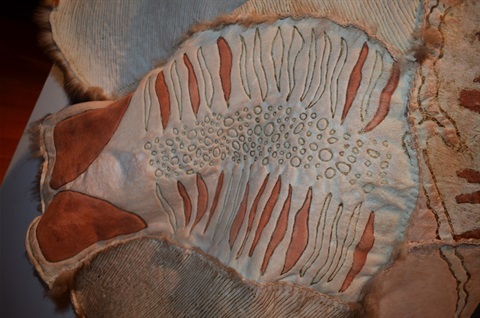Celebrated First Nations artist Vicki Couzens to give artist talk
Published on 13 July 2018

Gunditjmara woman and celebrated First Nations artist Aunty Vicki Couzens will give an artist talk on possum skin cloaks as part of the 2018 CrossXpollinatioN festival of fabric and textile art.
Couzens, who authored the world’s first PhD on possum skin cloaks in 2017, is helping Aboriginal communities across south-eastern Australia revive the ancient practice of creating cloaks as a way of reconnecting with their culture and heritage.
Grandmother’s Cloak, a piece created by Couzens in 2007 as a way of reconnecting with her grandmother Georgina Couzens (nee Winters) is currently on display at COPACC as part of CrossXpollinatioN.
Couzens’ artist talk on possum skin cloaks is free and will take place at COPACC on Wednesday, July 18 at 7pm.
Grandmother’s Cloak is part of a body of work created by Couzens entitled ‘Unseen’, and tells the story of a three-week period that Couzens spent walking across her grandmother’s country in the Heywood area.
On the skin side of the 25 panel cloak, Couzens has inscribed an aerial view of the Glenelg River and other significant cultural sites, and incorporated symbolism of the rare red tailed black cockatoo.
“The red tailed black cockatoo represents stories about moieties, or social structures,” Couzens said.
“I titled the body of work ‘Unseen’ because red tailed black cockatoos are rare and unseen, as is a lot of the cultural knowledge and stories of that area.
“It’s about the presence of the Gunditjmara people being unseen, unrecognised and unacknowledged.”
Striking at the heart of the ‘Unseen’ theme, Couzens’ grandmother never knew that her granddaughter created a possum skin cloak dedicated to her country and memory.
Georgina died when she was 53, and her granddaughter Vicki was just 10.
Couzens explained that people of her grandmother’s generation didn’t make cloaks for a variety of reasons including oppression during the colonisation era.
“In my grandparents’ era Aboriginal people weren’t allowed to engage in a range of cultural practices such as making cloaks.
“They were dispossessed of their land and therefore couldn’t access the resources required.
“Practicality also came into it – you didn’t make a cloak when you could buy a coat quicker and easier.
“Nan and Pop died after working hard all their lives as people of that generation did, and never got to see the fruits of their hard work in the way that my generation and my children have – we’ve had more freedom to pursue those practices that are our birthright.
“But the tradition is still there, waiting to be reinvigorated, it’s part of your DNA and heritage and stories.”
So embedded in Couzens’ persona was the tradition of possum skin cloak making that the craft found her.
While viewing the Lake Conda cloak at the Melbourne Museum in 1999, Couzens had a spiritual encounter that changed the course of her life.
“The old people who made the Lake Conda cloak sent a vision of reclaiming the cloak and bringing the practice back into community and following that I started making cloaks with people from Portland, Hall’s Gap and Warrnambool.
“It wasn’t until five years ago that a senior Gunditjmara woman told me that my Great Grandfather was one of six men from six families who made the Lake Conda cloak.
“It all made sense when she told me that – this oral history didn’t survive in my family but it did in their line.”
As part of NAIDOC Week 2018, Couzens is leading the Gulidjan people through the process of making a cloak for their community.
In the year that NAIDOC adopts the theme ‘Because of Her, We Can’ it’s fitting that a woman such as Couzens will bring the Gulidjan people together to create a cloak for their clan and learn the traditions of their ancestors.
Cloaks had a myriad of uses in Aboriginal communities including keeping people warm while sleeping, as drums during ceremonies, and as burial or ceremonial shrouds.
Couzens said cloaks were a high value commodity in south-eastern Australia, with one cloak being worth two stone axes.
The hollow fibres of possum fur are warmer and drier than any other pelt, and at the time were a plentiful resource in the area.
Today, Aboriginal people are taking the tradition of cloak making in a new contemporary direction, with some parents or grandparents making a swaddling cloak for newborns, which is added to as the child grows, effectively telling their life stories.
Couzens said the evolution of the practice was important.
“Nothing is set in stone; this is the 21st century so all practices need to change and grow.”
Aunty Vicki Couzens’ artist talk will take place on Wednesday, July 18 at 7pm at COPACC. Attendance is free but bookings are encouraged. Please RSVP to COPACC on 5232 9418 or copacc@colacotway.vic.gov.au
CrossXpollinatioN is proudly sponsored by Tarndie, Irrewarra Sourdough and Star Printing and brought to you by COPACC and the Red Rock Regional Theatre and Gallery.